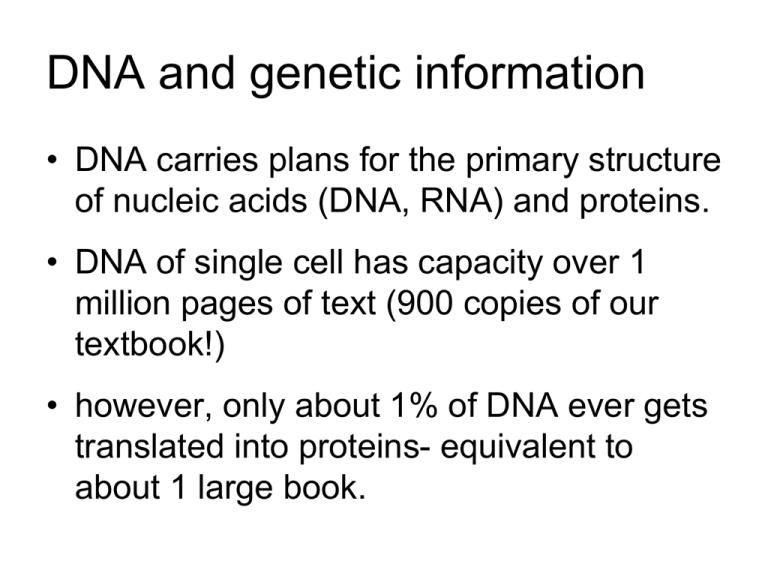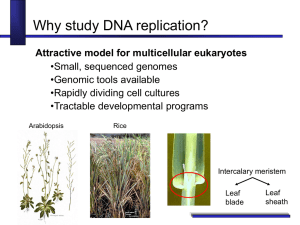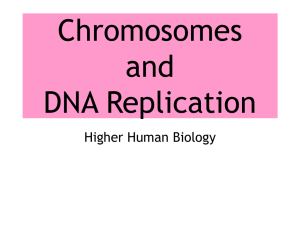DNA and genetic information
advertisement

DNA and genetic information • DNA carries plans for the primary structure of nucleic acids (DNA, RNA) and proteins. • DNA of single cell has capacity over 1 million pages of text (900 copies of our textbook!) • however, only about 1% of DNA ever gets translated into proteins- equivalent to about 1 large book. DNA is not all the information necessary in an organism (consider “Jurassic Park”) Information in binary computers • two basic symbols :1 or 0 (“bits”) • physical form of bits varies with medium • 8 bit words = bytes (e.g 10110111) • 28 = 256 unique bytes are possible • This is a large enough set of symbols to represent characters in language Information in binary computers • ASCII code- American Standard Code for Information Interchange • Each byte was assigned to a particular symbol (letter, numeral, etc.) • Therefore, series of bytes can represent English sentences, math equations, etc. Hierarchies of symbols English computer genetics letter (26) bit (2) nucleotide (4) word (1-28 letters) byte (8 bits) codon (3 nucleotides) sentence line gene book program genome Information in organisms • DNA and RNA- polymers of nucleotides • 4 letter alphabet = 4 kinds of nucleotides DNA: A, T, G, C RNA: A, U, G, C • sequence of nucleotides in a gene specifies the sequence of amino acids in a protein. Genetic code • "words" (codons or triplets) are 3 letters long in genetic code • each group of 3 nucleotides corresponds to one amino acid. • A nucleotide sequence (sequence of codons) can be “translated” into an amino acid sequence, i.e., a peptide or protein The triplet code Genetic code • the Genetic Code is the correspondence between triplets and amino acids • deciphered in early 60's by Marshall Nirenberg • He used synthetic polynucleotides and a cell-free translation system (e.g. poly-A gave poly-phenylalanine) The dictionary of the genetic code The genetic code is universal • This fact indicates a single origin for all living things. • A human gene placed in a bacterium or yeast cell can yield the same protein. • Biotechnology Genetic information undergoes 3 processes: • Replication to copy the DNA for cell reproduction • Transcription of genes into messenger RNA molecules for translation by ribosomes • Translation of mRNA by ribosomes into protein The structure of a DNA stand The double helix Base pairing in DNA James Watson and Francis Crick 1953 A model for DNA replication: the basic concept Three alternative models of DNA replication The Meselson-Stahl experiment tested three models of DNA replication (1958) Structure of DNA • Base pairing • Complementary strands • 5' and 3' ends, antiparallel • Leading and lagging strands • Template and complementary strands (=sense and antisense) The two strands of DNA are antiparallel Replication • Replication “origins” and “bubbles” -single in prokaryotes, multiple in eukaryotes Nucleoside triphosphates added Replication • DNA synthesis always starts with RNA primer (10 bases) laid first, later replaced with DNA • Leading strand is continuous • Lagging strand is discontinuous, in Okasaki fragments (100-200 bases long) • Ligase joins the fragments Synthesis of leading and lagging strands during DNA replication Priming DNA synthesis with RNA A summary of DNA replication The end-replication problem Question: are only half the copies affected? End-replication & telomeres • DNA polymerase can’t finish the 5’ ends • DNA would get 10 bases shorter each time replicated • Telomeres are “expendable” repetitive (TTAGGG) sequences at end of chromosomes • Telomerase restores telomers, present in germ-line cells and cancerous cells Telomeres and telomerase Telomerase includes an RNA component that is the pattern for the telomere DNA Telomeres and telomerase: Telomeres of mouse chromosomes








